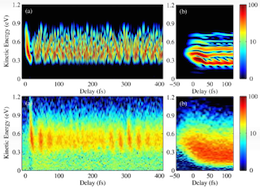Home > Research Teams > Dynamics and Interactions: Radiation, Atoms and Molecules (DIRAM) > Intense laser controlled molecular processes: Electronic and nuclear dynamics
Intense laser controlled molecular processes: Electronic and nuclear dynamics
O. Atabek, E. Charron, F. Gatti, A.Keller (LPMQ depuis le 01/01/2017), R. Lefebvre
Doctorant: Jérémy Viau-Trudel

- Measured (lower panel) and calculated (upper panel) kinetic energy distributions for two-colour XUV+IR dissociative ionization of H2+, making use of a 7fs (a) and a 35fs (b) pulses
Short intense laser pulses produce strong internal distortions in molecules, inducing thus selective dynamical effects both at the electronic and nuclear level, which can be exploited for imaging purposes or in designating control strategies.
In the high frequency vis-UV regime, the molecule feels an optical-cycle averaged force field. Its multiphoton nuclear dynamics is described through a time-periodic Floquet model based on photon-dressed electronic potentials. The control scenarios we are developing rest either on an appropriate weighting of antagonistic basic mechanisms of the dissociation process (bond softening versus vibrational trapping) or on some exceptional properties of scattering resonances (bifurcations or infinite duration). More specifically, such resonances are expected to play a crucial role in quantum filtering processes aiming at molecular cooling at ro-vibrational level. A specific choice of laser parameters is expected to selectively protect against depletion the ground ro-vibrational state of a thermal ensemble of molecules. The resulting single quantum state molecule present potential applications in quantum information. Our team is actively pursuing a collaboration involving experimentalists and theoreticians on systems like BaF, Na2, Cs2, LiCs, SrYb.
In the low frequency mid-IR regime, the ultrafast electronic and nuclear motions are expected to be unveiled through a so-called three-step rescattering mechanism. Concerning the electronic motion, for which the mechanism is well-documented in the literature, a tunnel ionization is followed by a laser assisted recollision, as a consequence of the sign change in the electric field amplitude within the optical period. The excess kinetic (ponderomotive) energy gained by the field acceleration is at the origin of several elastic or inelastic competing processes: laser induced electron diffraction (LIED), double ionization, harmonic generation (HHG) to cite a few. Our motivation in controlling the efficiency of such processes is both in relation with the production of ultra-short (attosecond regime) pulses and imaging or orbital tomography purposes. A similar recollision mechanism is expected for the nuclear wavepacket as the vibrational motion follows the field oscillations in a quasi-static adiabatic way on light-induced potential surfaces. In particular nuclear rescattering will follow tunnel dissociation. The consequences, in terms of possible harmonic emission for instance, are still to be exploited. We have been pioneers in the description of a so-called dynamical dissociation quenching (DDQ) mechanism resulting from an appropriate synchronization between the vibrational motion and the laser periods, which either completely suppress potential barriers or produces complete reflection of the wavefunction on them. A variety of molecular processes during photofragmentation are among our current research interests. The figure illustrates the degree of accuracy we are reaching within a full comprehensive frame for two pump (XUV atto-pulse) – probe (delayed intense IR pulse) experiments.
Intense laser controlled molecular processes
O. Atabek, E. Charron, A. Keller and R. Lefebvre are involved in this research theme.
Coulomb explosion of using intense sub-10fs laser pulses
Eric Charron, Sébastien Saugout et Annick Suzor-Weiner
Femtosecond Electron Diffraction
During the ultrashort laser pulse-molecule interaction, it should be possible to extract information concerning the geometric characteristics of the molecule, like the internuclear distance, using the rescattering mechanism.
Osman Atabek, Eric Charron, Arne Keller, Michel Peters and Sébastien Saugout
Full electro-nuclear dynamics of molecules irradiated by intense, ultra short laser pulses
Jérémy Viau Trudel, PhD in progress (2nd year), Co-supervised doctoral thesis France (O. Atabek, Université Paris-Sud) / Canada (T.T. Nguyen-Dang, Université Laval)
Intense and ultra short laser induced molecular photofragmentation (ionization and dissociation) is studied referring to multielectronic ab-initio dynamical calculations. Electronic and nuclear dynamics are taken into account on an equal footing through a full quantum many particle model accurately describing electron correlations


